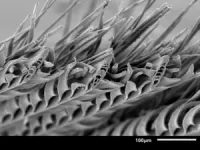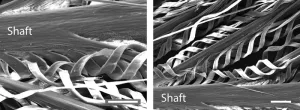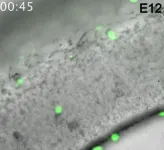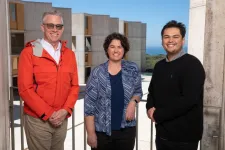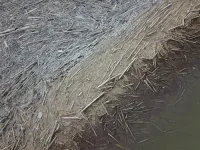(Press-News.org) An extreme closeup of feathers from a bird with an uncanny ability to hold water while it flies could inspire the next generation of absorbent materials.
With high resolution microscopes and 3D technology, researchers at Johns Hopkins University and Massachusetts Institute of Technology captured an unprecedented view of feathers from the desert-dwelling sandgrouse, showcasing the singular architecture of their feathers and revealing for the first time how they can hold so much water.
“It’s super fascinating to see how nature managed to create structures so perfectly efficient to take in and hold water,” said co-author Jochen Mueller, an assistant professor in Johns Hopkins’ Department of Civil and Systems Engineering, who specializes in smart materials and design. “From an engineering perspective, we think the findings could lead to new bio-inspired creations.”
The work is published today in The Royal Society Interface.
Sandgrouse found in African deserts typically nest about 20 miles from watering holes to stay safe from predators. To get water home to thirsty chicks, the adult males perform one of nature’s best examples of carry out, gathering water and flying home with it, a feat made even more extraordinary considering the sandgrouse is holding about 15% of his body weight in water, and keeping most of it safe during a roughly 40 mph flight home that takes about a half hour.
The male sandgrouse are the only birds known to hold water like this—their specially adapted belly feathers are the key.
Other researchers first documented these extraordinary belly feathers more than 50 years ago. But only here with modern technology the team can finally demonstrate how the feathers work.
Mueller and MIT engineer Lorna J. Gibson zeroed in on the microstructure of the belly feathers using scanning electron microscopy, microcomputed tomography, light microscopy and 3D videography, looking closely at the shafts, each just a fraction of the width of a human hair, and the even tinier individual barbules.
The team greatly magnified the feathers, observing them both dry and wet. Then, in a move as delicate as it was crucial, while magnified the dry feathers were dunked in water, pulled out, then re-submerged, just like a sandgrouse at a watering hole.
“When you do that type of work, you can’t even breathe or else you blow it away,” Mueller said.
Mueller described the individual feather structure as “magnificent,” with components optimized in several ways to hold and retain water, including the way they bend, how the barbules form protective tentlike clusters when wet, and how tubular structures within each barbule capture water.
Individual feathers held the water through a forest of barbules near the shaft, working together with the curled barbules near the tip acting almost like caps.
“That’s what excited us, to see that level of detail,” Mueller said. “This is what we need to understand in order to use those principles to create new materials.”
The team also computationally modeled the water intake of the feathers.
Mueller and Gibson expect their findings will underpin future engineering designs requiring controlled absorption, secure retention, and easy release of liquids.
Possible applications include the design of netting for collecting and retaining water from fog and dew in desert regions; and a water bottle designed to prevent annoying swinging and sloshing.
For the water bottle or sports backpack, he’s thinking about a design that safely holds a lot of liquid, but includes an inner feather-like system that keeps the water from swinging around while someone moves with it. He thinks a hydration pack or water bladder that could do this would be particularly appreciated by runners.
He also imagines next-level medical swabs that are easier to use, “where you can efficiently soak up liquid, but it’s much easier to release it,” he says, adding that the release feature was an issue for collecting COVID-19 nasal test samples during the pandemic.
Next the team plans to print similar structures in 3D and pursue commercial applications.
Belly feathers used in this work were obtained from a single male adult Namaqua sandgrouse (Pterocles namaqua) in the collection of the Harvard University Museum of Comparative Zoology. The work was also supported by National Science Foundation grant (DMR-1922321)
END
How an African bird might inspire a better water bottle
2023-04-12
ELSE PRESS RELEASES FROM THIS DATE:
Time-restricted fasting could cause fertility problems
2023-04-12
Time-restricted fasting diets could cause fertility problems according to new research from the University of East Anglia.
A new study published today shows that time-restricted fasting affects reproduction differently in male and female zebrafish.
Importantly, some of the negative effects on eggs and sperm quality can be seen after the fish returned to their normal levels of food consumption.
The research team say that while the study was conducted in fish, their findings highlight the importance of considering not just the effect of fasting on weight and health, but also on fertility.
Prof Alexei Maklakov, from UEA’s School of Biological Sciences, said: “Time-restricted ...
Scientists uncover the amazing way sandgrouse hold water in their feathers
2023-04-12
Many birds’ feathers are remarkably efficient at shedding water — so much so that “like water off a duck’s back” is a common expression. Much more unusual are the belly feathers of the sandgrouse, especially Namaqua sandgrouse, which absorb and retain water so efficiently the male birds can fly more than 20 kilometers from a distant watering hole back to the nest and still retain enough water in their feathers for the chicks to drink and sustain themselves in the searing deserts ...
Alternative route used by specialized immune cells to colonize the embryonic brain suggests new approach to fighting fetal brain dysfunction
2023-04-12
A team from the Nagoya University Graduate School of Medicine in Japan has uncovered new information about how microglia, the resident immune cells in the brain, colonize the brain during the embryonic stage of development. Although erythromyeloid progenitors (EMPs) were previously thought to divide into either microglia or macrophages, the group found that macrophages that enter the brain primordium —the brain in its earliest recognizable stage of development— can become microglia at later stages of development. These findings demonstrate the plasticity of these ...
The brain’s cannabinoid system protects against addiction following childhood maltreatment
2023-04-12
High levels of the body’s own cannabinoid substances protect against developing addiction in individuals previously exposed to childhood maltreatment, according to a new study from Linköping University in Sweden. The brains of those who had not developed an addiction following childhood maltreatment seem to process emotion-related social signals better.
Childhood maltreatment has long been suspected to increase the risk of developing a drug or alcohol addiction later in life. Researchers at Linköping University have previously shown that this risk is three times higher if you have been exposed to childhood maltreatment ...
Pregnant women show robust and variable immunity during COVID-19
2023-04-12
New research from the Peter Doherty Institute for Infection and Immunity (Doherty Institute) has found that pregnant women display a strong immune response to SARS-CoV-2 infection, comparable to that of non-pregnant women.
Published in JCI Insight, the study looked at the immune responses to SARS-CoV-2 in unvaccinated pregnant and non-pregnant women and found similar levels of antibodies and T and B cell responses, responsible for long-term protection.
Lead author of the paper, University of ...
Antimicrobial stewardship programs essential for preventing C. difficile in hospitals
2023-04-12
ARLINGTON, Va. (April 12, 2023) — Five medical organizations say it is essential that hospitals establish antimicrobial stewardship programs to prevent Clostridioides difficile (C. difficile) infections. These infections, linked to antibiotic use, cause difficult-to-treat diarrhea, longer hospital stays, and higher costs. C. difficile infections are fatal for more than 12,000 people in the United States each year.
Strategies to Prevent Clostridioides difficile Infections in Acute Care Hospitals: 2022 Update, gives evidence-based, ...
Mitochondria power-supply failure may cause age-related cognitive impairment
2023-04-12
LA JOLLA—(April 12, 2023) Brains are like puzzles, requiring many nested and codependent pieces to function well. The brain is divided into areas, each containing many millions of neurons connected across thousands of synapses. These synapses, which enable communication between neurons, depend on even smaller structures: message-sending boutons (swollen bulbs at the branch-like tips of neurons), message-receiving dendrites (complementary branch-like structures for receiving bouton messages), and power-generating mitochondria. To create a cohesive brain, all these pieces must be accounted for.
However, in the aging brain, these ...
Education and peer support cut binge-drinking by National Guard members in half, study shows
2023-04-12
A new study shows promise for reducing risky drinking among Army National Guard members over the long term, potentially improving their health and readiness to serve.
The number of days each month that Guard members said they had been binge-drinking dropped by up to half, according to the new findings by a University of Michigan team published in the journal Addiction.
The drop happened over the course of a year among Guard members who did multiple brief online education sessions designed for members of the military, and among those who did an initial online education session followed by supportive ...
World’s biggest cumulative logjam, newly mapped in the Arctic, stores 3.4 million tons of carbon
2023-04-11
WASHINGTON — Throughout the Arctic, fallen trees make their way from forests to the ocean by way of rivers. Those logs can stack up as the river twists and turns, resulting in long-term carbon storage. A new study has mapped the largest known woody deposit, covering 51 square kilometers (20 square miles) of the Mackenzie River Delta in Nunavut, Canada, and calculated that the logs store about 3.4 million tons (about 3.1 million metric tons) of carbon.
“To put that in perspective, that’s about two and a half million ...
Life cycle assessment can help with the transition to the circular economy
2023-04-11
According to Bening Mayanti's doctoral dissertation at the University of Vaasa, the use of life cycle assessment combined with economic models can help companies to take steps toward the circular economy.
– We often hear claims about some solutions being circular, sustainable, or green. Instead of blindly accepting those claims, we should ask justifications, ‘How so?’ says Mayanti, who publicly defended her dissertation on Wednesday, 5 April.
Before deciding on circular economy solutions and building supply chains, it is worth doing a careful analysis. ...


